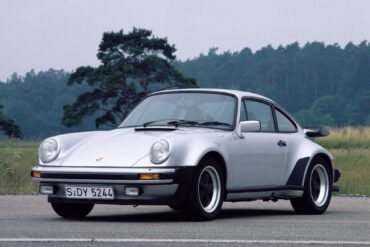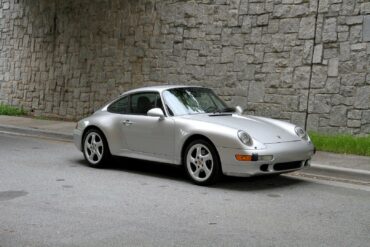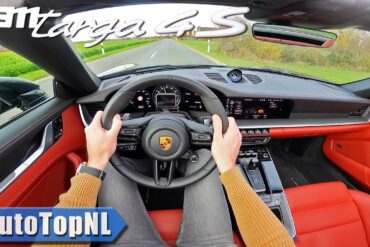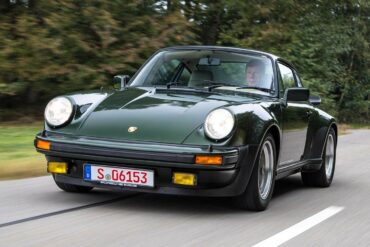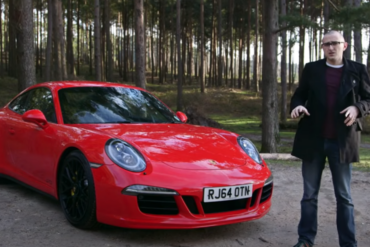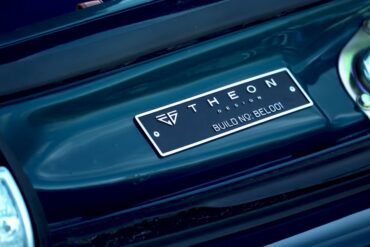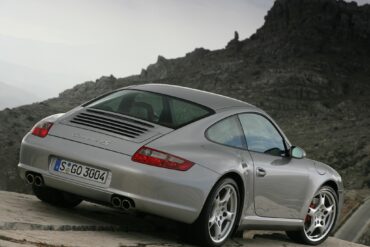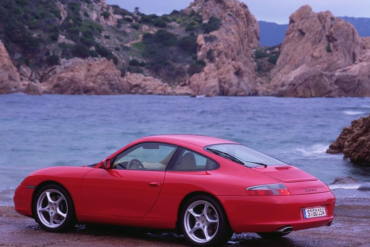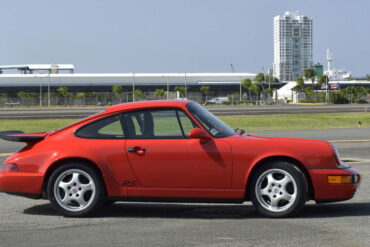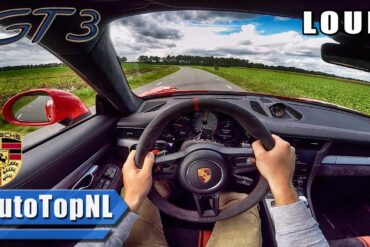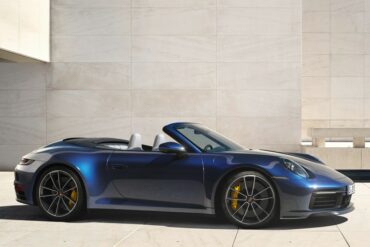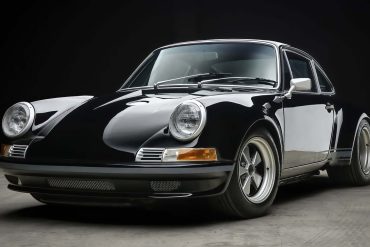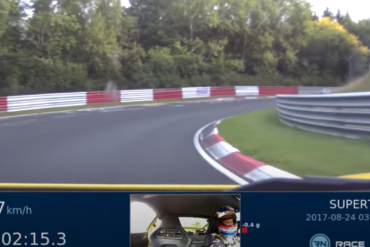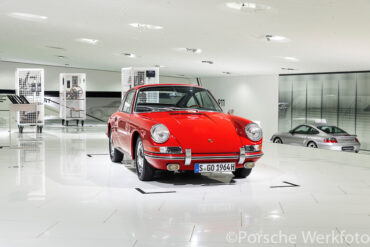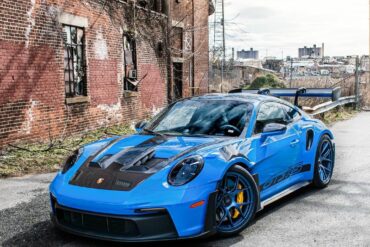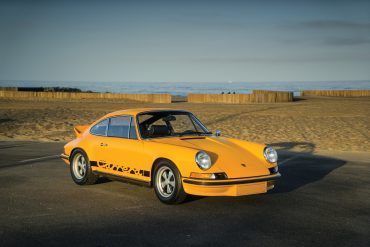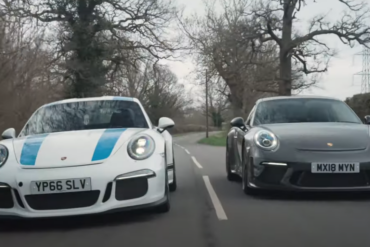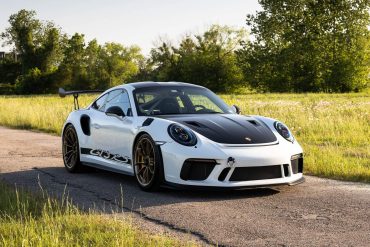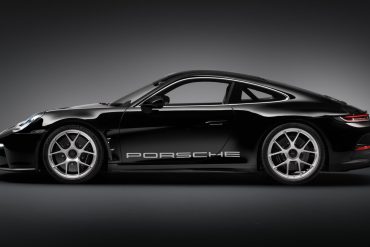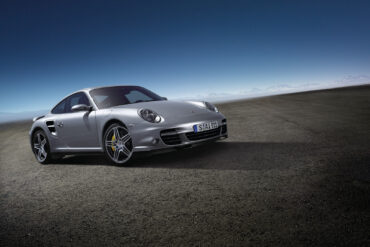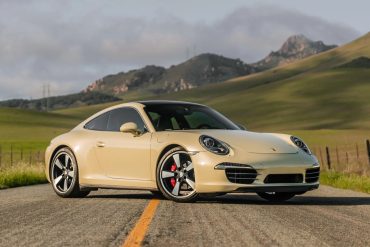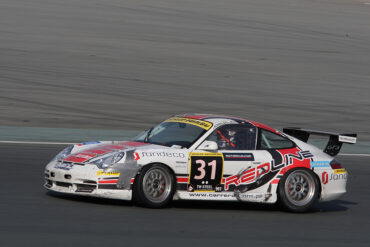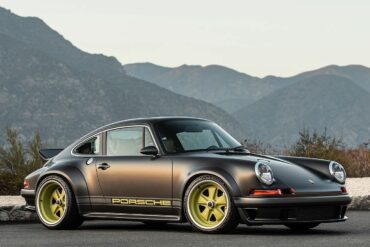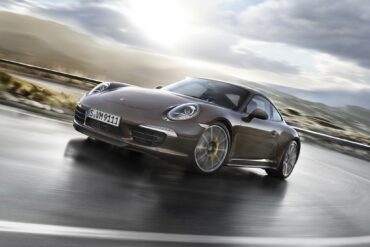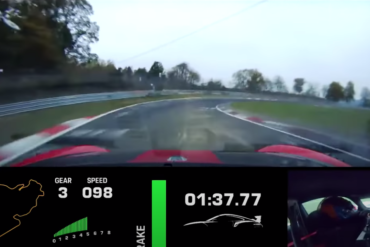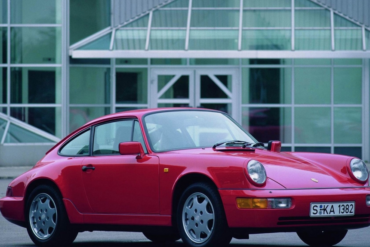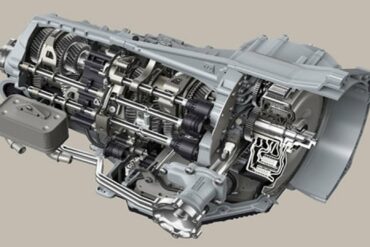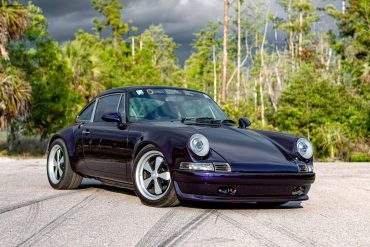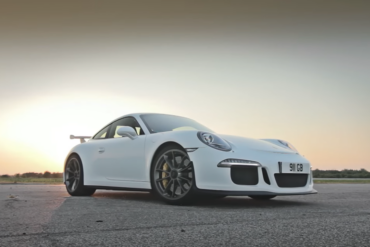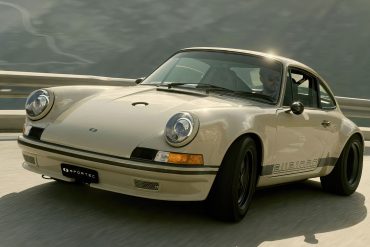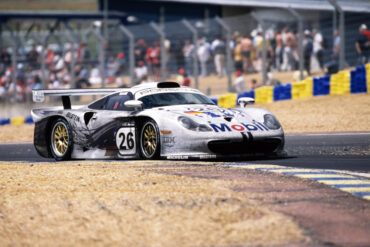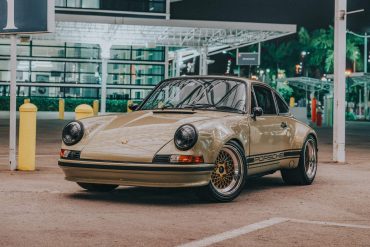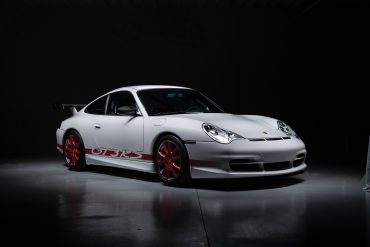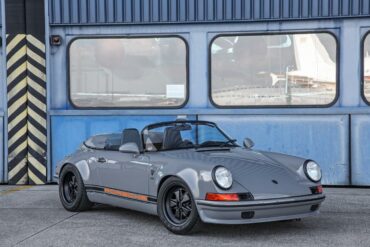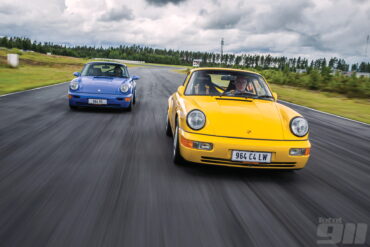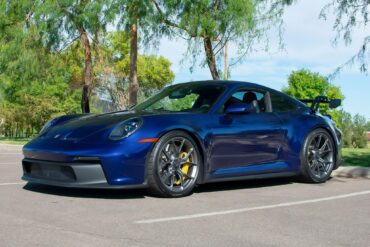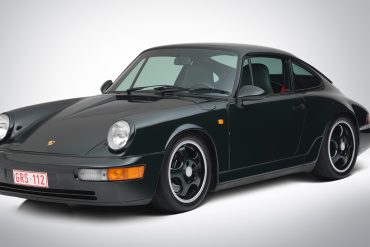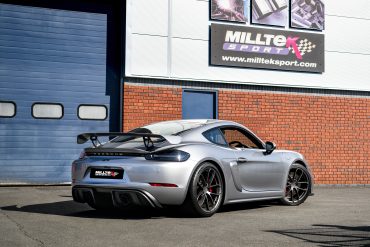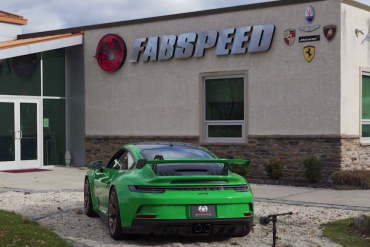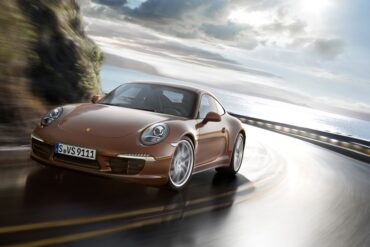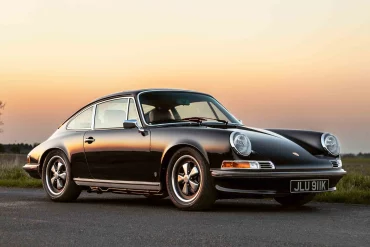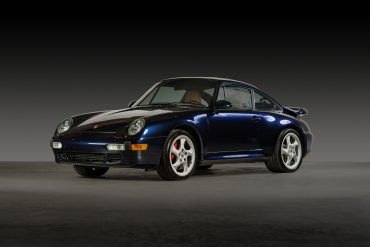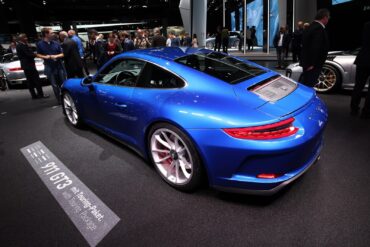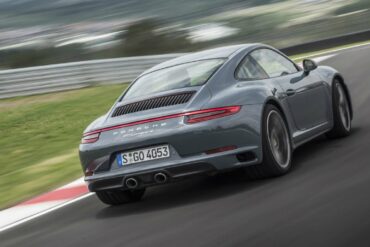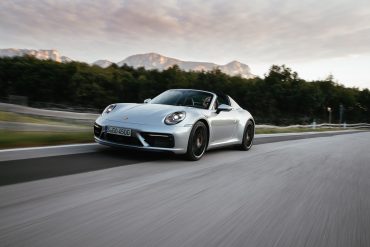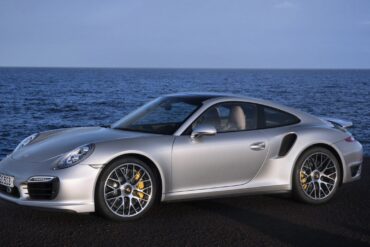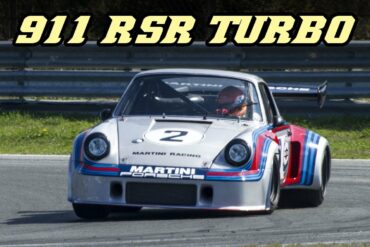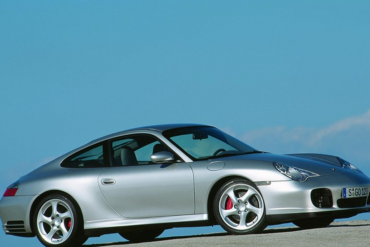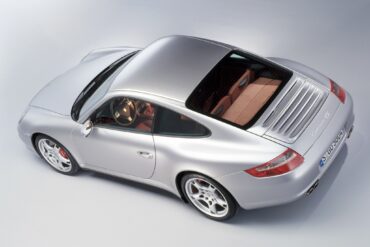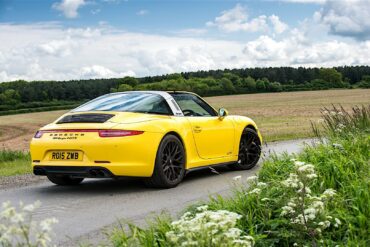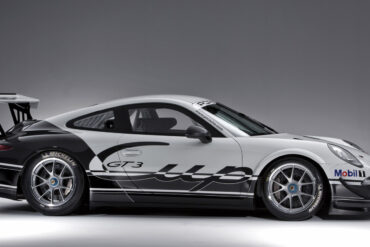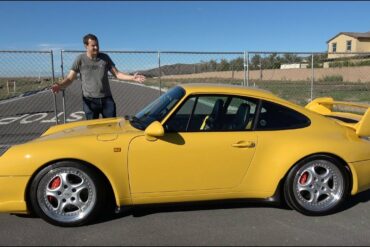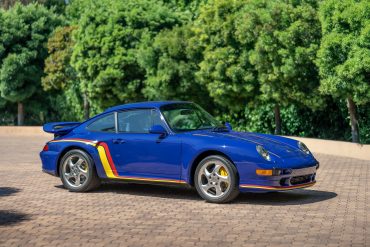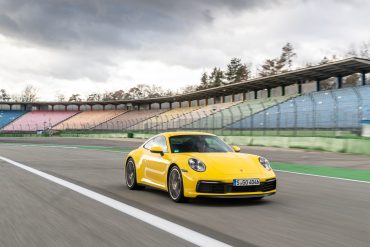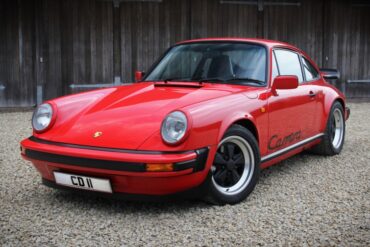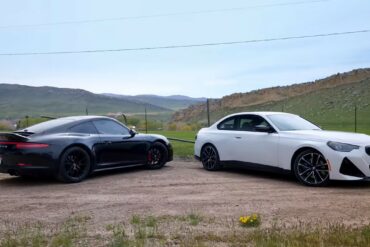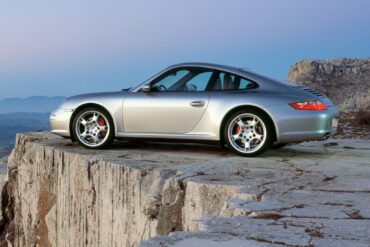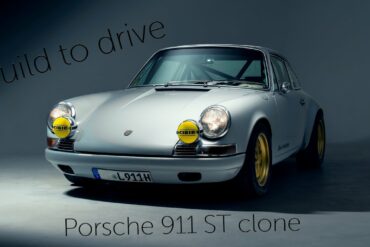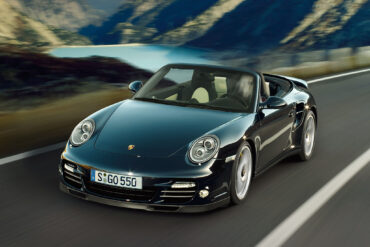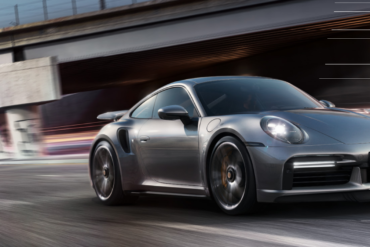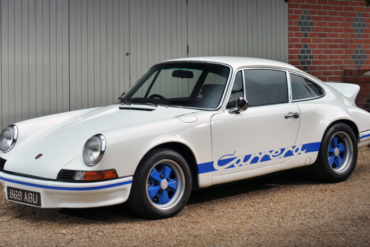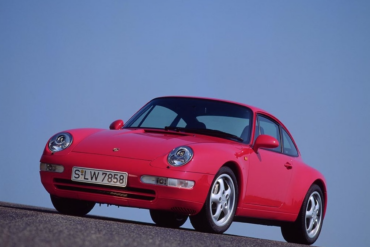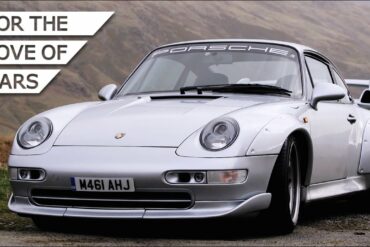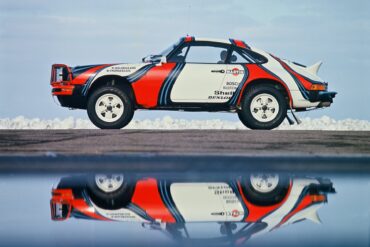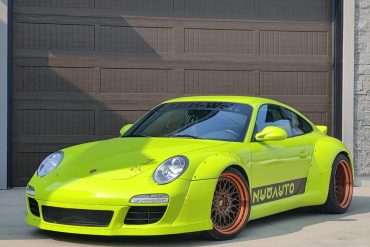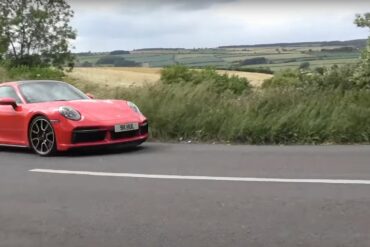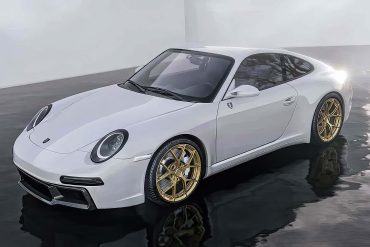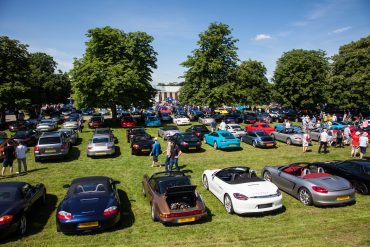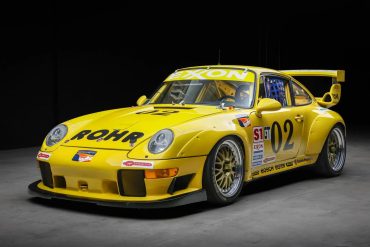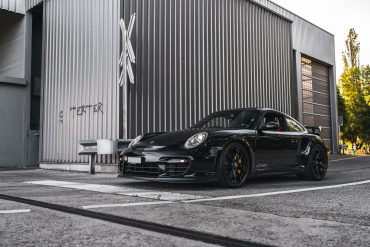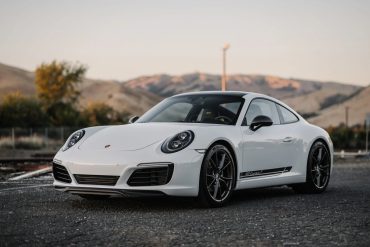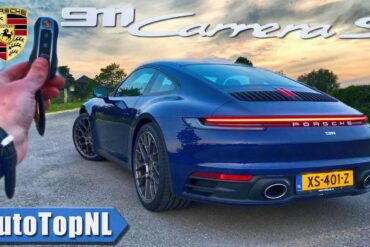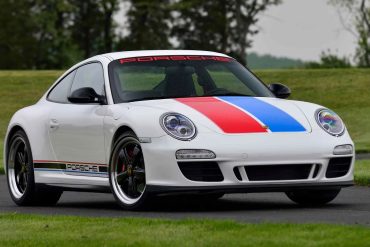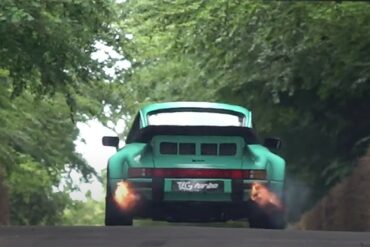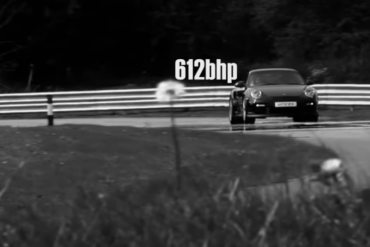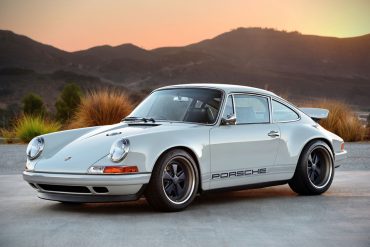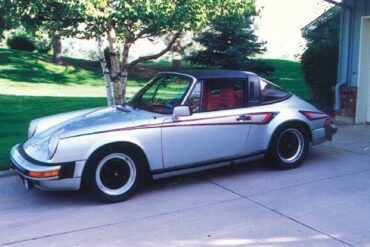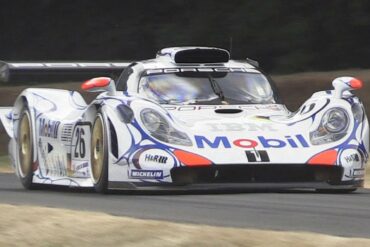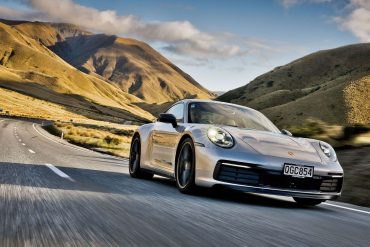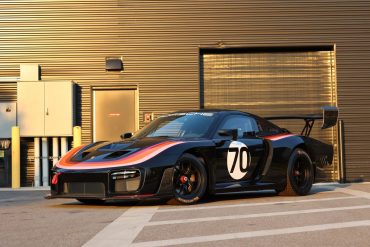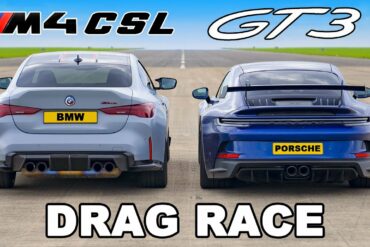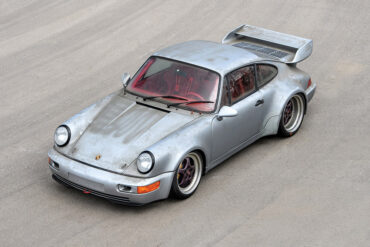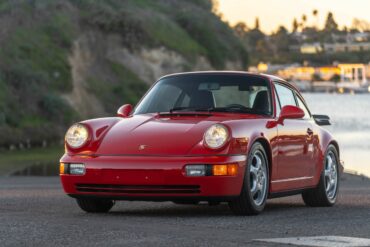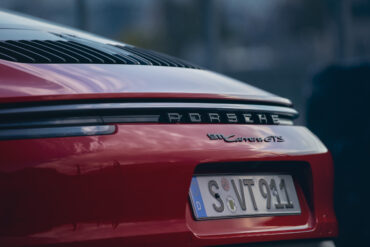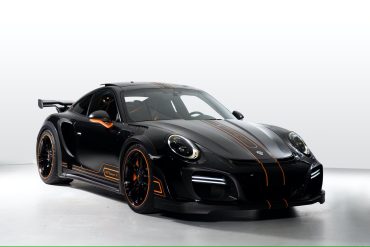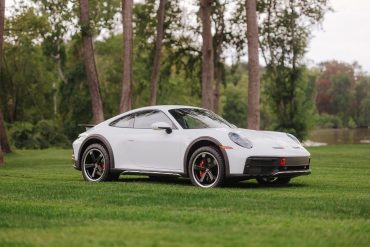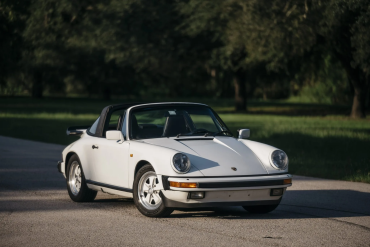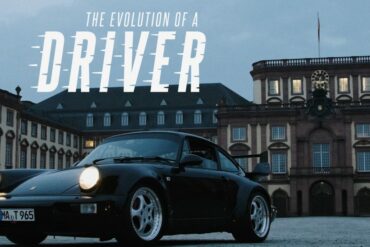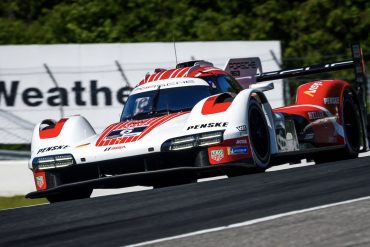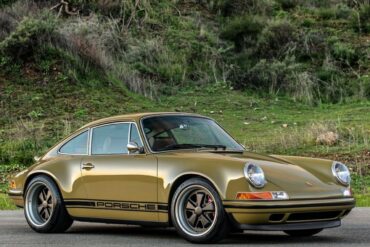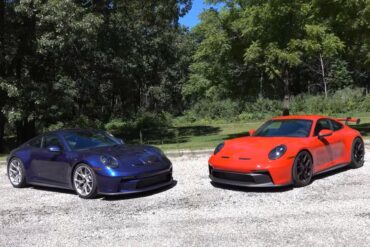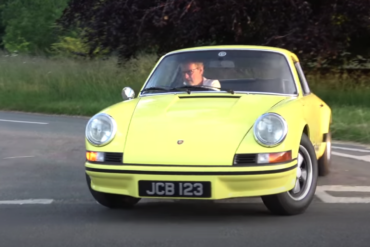Porsche made its first and most significant changes to the 930 for 1978 model year, enlarging the engine bore by 2 mm (0.08 in) to a total displacement of 3,299 cc (3.3 L; 201.3 cu in) and adding an air-to-air intercooler. The suspension benefitted from new anti-roll bars, firmer shocks and larger diameter rear torsion bars. While the increase in displacement increased power output and torque, it also increased the weight of the vehicle, which contributed to a substantial change in the handling and character of the car compared to the Earlier 3.0-Litre Models.
Porsche 911
All
- Porsche 912
- 911 Carrera RS 2.7
- Porsche 901 (911)
- Porsche 911 (F-Series)
- Porsche 911 (991)
- Porsche 911 (G-Series)
- Porsche 911 (964)
- Porsche 911 (993)
- Porsche 911 (996)
- Porsche 911 (997)
- 911 Speedster Concept
- Porsche 911 (992)
- 964 Carrera 2
- 964 Carrera 4
- ’30 Jahre’ Anniversary
- 964 Speedster
- 964 Turbo
- 964 Carrera RS
- 964 Carrera Cup
- 964 RSR
- 993 Carrera
- 993 Carrera 4
- 911 Edition 50
- 993 Carrera 4S
- 911 2.0 Bertone Roadster
- 993 Carrera S
- 993 Targa
- 992 Sport Classic
- 993 Turbo
- 996 Carrera
- 993 Carrera RS
- 992 America Edition 911
- 996 Carrera 4
- 993 GT2
- 996 Targa
- 993 Carrera Cup
- 996 Carrera 4S
- 996 Turbo
- 996 Turbo S
- 996 GT3
- 996 GT3 RS
- 996 GT2
- 996 GT3 Cup
- 996 GT3 R
- 996 GT3 RSR
- 997 Carrera
- 996 GT3 RS Race
- 997 Carrera S
- 997 Carrera 4
- 997 Carrera 4S
- 997 Targa
- 911 Carrera 3.0 Coupe (G-Series)
- 997 Targa 4S
- 997 Turbo
- 997 Turbo S
- 997 GT2
- 992 Carrera T
- 997 GT2 RS
- 997 Speedster
- 997 Carrera GTS
- 992 Dakar
- 997 Carrera 4 GTS
- 997 GT3 Cup
- 997 GT3 R
- 997 GT3 RSR
- 997 GT3
- 997 GT3 RS
- 997 GT3 R Hybrid
- 991 Carrera
- 991 Carrera 4
- 991 Carrera S
- 991 Carrera 4S
- 991 Targa 4
- 991 Targa 4S
- 991 Turbo
- 991 Turbo S
- 991 Carrera GTS
- 991 Carrera 4 GTS
- 991 Targa 4 GTS
- 991 911 R
- Porsche 992 GT2 RS
- 991 GT3
- 991 GT3 RS
- 991 GT2 RS
- 991 Speedster
- 991 GT3 R
- 991 GT3 Cup
- 991 RSR
- 991 Carrera T
- 992 Carrera 2
- 992 Carrera 4
- 992 Carrera S
- 992 Carrera 4S
- 992 Targa 4
- 992 RSR
- 992 Targa 4S
- 992 Carrera GTS
- 992 Carrera 4 GTS
- 992 Targa 4 GTS
- 992 Turbo
- 992 GT3 R
- 992 Turbo S
- 992 GT3
- 992 GT3 Touring
- 992 911 S/T
- 911 (G-Series)
- 992 GT3 RS
- 992 GT2 RS
- 992 GT3 Cup
- 911 Carrera 3.0 (G-Series)
- 911 S (G-Series)
- 911 Carrera RSR 2.8
- 911 SC (G-Series)
- Porsche 992 GT3 R Rennsport
- 911 S/T
- 911 Carrera 3.2 (G-Series)
- 911 (Base Model)
- 911 Turbo (930)
- 911 SC Safari
- 911 L
- 911 Carrera RSR Turbo 2.1
- 911 T
- 911 Carrera RSR 3.0
- 911 E
- 911 S
- 911 SC San Remo
- 911 Carrera 3.2 Clubsport
- 911 R
- Porsche 953
- 911 Carrera RS 3.0
- 911 T/R
- 911 Carrera 25th Anniversary
- 911 SC RS
- 911 Turbo LE
- 911 Carrera Commemorative
- 911 Carrera 2.7 (G-Series)
- 911 3.2 Speedster
- 911 Turbo 2.7
- 964 Turbo S
1997 Porsche 911 Carrera (993) Technical Specifications Engine Type Flat 6 Induction Naturally Aspirated Cooling Air/oil-cooled Valvetrain Single overhead camshaft...
In Depth Review of the 992 Carrera GTS The New 992 Porsche 911 Carrera GTS might be the ultimate sweet...
Porsche Option Codes – Porsche 911 (1975 Model Year) Looking to decode your 1975 Porsche 911 option codes? Want to...
991 911 Carrera GTS Review The Porsche 911 Carrera GTS (991) stretches what the original GTS stood for but in real...
Autocar reviews a 964-generation Porsche 911 which has been modified by Theon Design, a firm based in Oxfordshire. Find out...
2006 Porsche 911 Carrera 4S Coupe (997) Technical Specifications Engine Type Flat 6 Induction Normally-aspirated Cooling Water-cooled Valvetrain Double overhead...
2002 Porsche 911 Carrera Coupe (996.2) Technical Specifications Engine Type Flat 6 Induction Normally-aspirated Cooling Water-cooled Valvetrain Double overhead camshafts...
1991-1992 Porsche 911 Carrera RS (964) Technical Specifications Engine Type Flat 6 Induction Naturally Aspirated Cooling Air/oil-cooled Valvetrain Single overhead...
991.2 911 GT3 POV Driving Impressions Porsche 911 GT3 (991.2) POV Test Drive INSANE SOUND!! by AutoTopNL...
2023 Porsche 911 Carrera 4 Cabriolet (992) Technical Specifications Engine layout Rear Engine Engine type Boxer, twin-turbo Cylinders 6 Valves per...
Is going backward the way forward? The Porsche 911; I can’t think of another sports car that better represents an...
Porsche 911 (991.2) Turbo S 7.17 min Nordschleife Sport auto test driver Christian Gebhardt in the Porsche 991.2 Turbo S...
The Porsche 992 Turbo S is an astonishingly fast and capable vehicle that blends exceptional performance, comfort, and everyday usability,...
Performance, Engine, Styling & More The Porsche 911 GT3 Touring is a race-oriented sports car that has been absent from...
1965 Porsche 901 chassis #57 After three years of restoration, the Porsche Museum will finally present one of the newest...
Arguably the most extreme 911 to be build as a production car for the road and track. The most significant...
Revealed at the 1972 Paris Auto Show, the Carrera 2.7 RS was a special model used to homologate the 911 in Group...
Two Amazing Choice – The Porsche 911 R & 911 GT3 Touring The 911 R is one of the rarest...
In 2018, Porsche introduced the facelifted 991.2 version of the 911 GT3 RS. This updated model featured redesigned aerodynamic bodywork...
Unsurprisingly, limited edition 911 models are hotter than the face of the sun, with six-digit markups the norm for recent...
Porsche 911 (997) Sales & Production Numbers In total, the Porsche 997 sold 212,964 units over its production life. It...
The 2014 50th Anniversary Edition 911 was built by Porsche to commemorate the 911’s birthday, 50 years after its production...
2002 Porsche 911 GT3 Cup (996) Technical Specifications Type Racing Car Built at Germany Engine Flat-6 w/Dry Sump Lubrication Position...
Singer Vehicle Design – Naples Commission Today, we take a closer look at the Singer Vehicle Designs Naples Commission. This...
2013 Porsche 911 Carrera 4S (991) Technical Specifications Engine Type Flat 6 Induction Normally-aspirated Cooling Water-cooled Valvetrain Four overhead camshafts, four...
Porsche 911 GT2 RS Nurburgring Video Porsche set a new record for road-approved sports cars on the 20.6-kilometre Nürburgring Nordschleife...
Porsche added the rear wheel drive Carrera 2 variant to the range in 1990. It was developed alongside the 964 Carrera 4, Porsche waited a year to release the Carrera 2 as a 1990 model year car. Like the Carrera 4, the Carrera 2 was available as a coupé, Targa or Cabriolet. Overall, the Carrera 2 packed almost the same technical specifications as the Carrera 4 model. The engine was the same 3.6 liter unit which produced 250 horsepower and a maximum speed of 162 mph. Looked like C4 but was 200 lb lighter and more fun to drive.
Porsche 911 (997) Transmission Codes The transmission number code is found on the transmission data plate. Code Transmission Model years...
The unique restoration of this 1992 Porsche 964 Carrera 2 Coupe was exclusively commissioned to Olsen Motorsports, who carried out...
The Story of the Porsche 911 – A Timeline Porsche Prepares To Evolve Beyond The 356 By the early 1960’s,...
A Thorough Review of the 991 GT3 The all-new 991-generation Porsche 911 GT3 faces its toughest challengers on road and...
If you’re ready to imagine the next “ultimate restomod” 911, you’ve come to the right place. Located in Switzerland just...
1997 Porsche 911 GT1 Evolution Technical Specifications Engine: Water-cooled six-cylinder four-stroke horizontally opposed engine, two turbochargers, two controlled metal-substrate catalytic...
M5 vs 911 Turbo Drag Race The 2022 BMW M5 CS ($170,800 CAD as specced, ~$143,000 USD) is an absolute...
This 1979 Porsche 911SC pays homage to the iconic 911 RSR and ST racing cars with a meticulous restoration and...
Last year JayEmm (a Porsche-focused YouTuber) made a video talking about the fact he may never want another 911. In...
The 2004 Porsche 911 GT3 RS serves as a homologation model, designed to comply with the new international GT rules...
A Stunning Speedster Restomod You guys already know we’re huge fans of DP Motorsport thanks to a steady flow of...
Rare & Special Race Versions of the 964 For issue 131 of Total 911, you may remember that we made...
If you are lucky enough to get an allocation on a 992 GT3, you should do whatever you can in...
Porsche introduced the 964 Carrera RS for the 1992 model year, specifically targeting the European market as a lightweight, high-performance...
The leading premium performance exhaust manufacturer, Milltek Sport, is working on creating an even more dynamic Porsche 911 (992) with...
Fabspeed Motorsport has been setting the industry standard for quality and performance since 1994 and we continue to revolutionize the...
2015 Porsche 911 Carrera 4 Coupe (991) Technical Specifications Engine Type Flat 6 Induction Normally-aspirated Cooling Water-cooled Valvetrain Four overhead camshafts,...
Classic Touring Series II Restomod If you like the idea of a classic 911, but secretly desire a 21st century...
This is the last of the aircooled 911 turbos. Porsche introduced the Turbo for the 1995 model year. It had...
Porsche never fails to impress us when it comes to creating niches with their introduction of a new edition 911...
2019 Porsche 911 Carrera 4 Coupe (991.2) Technical Specifications Engine layout Rear Engine Engine type Boxer, twin-turbo Cylinders 6 Valves per...
2022 Porsche 911 Targa 4 GTS (992) Technical Specifications Model 911 Targa 4 GTS Design and cylinders Twin-turbo boxer 6 Number...
Porsche Option Codes – Porsche 911 (2014 Model Year) Looking to decode your 2014 Porsche 911 option codes? Want to...
Porsche 911 Carrera RSR Turbo 2.1 On Track This is a 911 that wrote a big part of Porsche history....
2003 Porsche 911 Carrera 4S Coupe (996) Technical Specifications Engine Type Flat 6 Induction Normally-aspirated Cooling Water-cooled Valvetrain Double overhead...
2008 Porsche 911 Carrera 4S Coupe (997) Technical Specifications Engine Type Flat 6 Induction Normally-aspirated Cooling Water-cooled Valvetrain Double overhead...
2015 Porsche 911 Targa 4 GTS (991) Technical Specifications Porsche Models Technical Data 911 Targa 4 GTS Engine Engine layout Rear...
2013 – 2016 Porsche 911 GT3 Cup (991) Pictures & Gallery...
Porsche 911 Carrera RS Is the Forbidden 993 The Porsche 911 Carrera RS is the forbidden 993. It’s the lightweight,...
In 1997, Porsche introduced the 993 Turbo S, a limited-production model that served as a magnificent farewell to the era...
2020 Porsche 911 Carrera S (992) Technical Specifications PDK 992 Carrera S Specs Model 2020 911 Carrera S Engine Engine layout...
1987 – 1989 Porsche 911 Carrera 3.2 CS Pictures & Gallery...
Everyday Driver compares and contrasts the Porsche 911 Carrera 4S and the BMW M240i. Guess which car comes out on...
2007 Porsche 911 Carrera 4S Coupe (997) Technical Specifications Engine Type Flat 6 Induction Normally-aspirated Cooling Water-cooled Valvetrain Double overhead...
Clean & Fast 911 ST Clone Karsten has build his Porsche the way he wanted it. Clean an fast, like...
The heart of this most exclusive high-performance athlete is of course a six-cylinder boxer boosted by two exhaust gas turbochargers with variable turbine geometry, with an increase in power over the 911 Turbo by 30 to 530 bhp (390 kW). Maximum torque is a most impressive 700 Newton-metres (516 lb-ft). At the same time this new top model comes as standard with all high-tech components available only as options on the “regular” 911 Turbo. The 911 Turbo S comes exclusively with seven-speed Porsche-Doppelkupplungsgetriebe (PDK) conveying drive power to PTM all-wheel drive.
Porsche 911 Sales Brochures (Type 992) We found quite a few Porsche sales brochures for the Type 992 911 generation....
Porsche 911 Carrera RS 2.7 1973 Porsche 911 Carrera RS 2.7 Engine: 2,687 cc, air-cooled horizontally flat six Production dates:...
The 993 Carrera 4, sold between 1995 and 1998, uses the same powerplant as the standard 993 Carrera, but puts power down to all four wheels through a 6-speed manual transmission. A “Carrera 4” badge on the tail, along with silver-painted brake calipers and clear front and side turn signals, help distinguish the all-wheel drive C4 from the C2 sibling. Approximately 4,700 coupes and 2,500 cabriolets were made. It was replaced by the Porsche 911 Carrera 4 (996 generation) in 1999.
Porsche 911 (993) GT2 Driven Charles Morgan takes us through one of his favourite cars – the 911 993 GT2....
In 1978, the works team fields two 911 SC at the East African Safari Rally. The name of game is to survive 5,000 kilometres of the toughest tracks in sweltering heat and torrential rain. The conditions take their toll: of the 72 starters, 13 reach the finish line. Martini Racing Porsche System Engineering signs on two specialists to drive: Sweden’s Björn Waldegård (Start No. 5) and Kenyan Vic Preston Jnr (Start No. 14).
In September 2023, Akira Nakai of RAUH-Welt Begriff customized this 2009 Porsche 911 Carrera S coupe, one of three such...
Porsche mania seems to be taking over at the moment, mostly because the 2020 Type 992 911 Turbo S has...
Edit Automotive has unveiled its vision of the Porsche 911 named the g11, an intricately crafted sports car predicated on...
On June 5, Sunday, a huge Porsche-themed event will be held on the grounds of the National Motor Museum, in...
Developed by Porsche to fulfill FIA GT racing homologation requirements, the 993 GT2 was derived from the 993 Turbo. It...
The Porsche 997 GT2 RS is best described as extreme. With a top speed of 209 MPH, it boasts a...
To the untrained eye, the Carrera T may appear to be a bare-bones and sparingly equipped 911 at first glance. With a...
Awesome 992 Carrera S Review Porsche 911 992 Carrera S REVIEW POV Test Drive on AUTOBAHN & ROAD by AutoTopNL...
Porsche and Brumos Racing have once again delved into their shared history to craft an exceptional Porsche 911 Carrera GTS...
Who Wants A Street-Legal F1 Engined Porsche? We recently took a look at the TAG-Turbo 911 (Powered by Lanzante) and today...
Auto Express Reviews The 997 Porsche 911 GT2 RS The 911 GT2 RS is the fastest and most powerful production...
Singer Vehicle Design has entered into a historic agreement with Porsche Motorsport North America. It is a partnership that will...
The 'Martini' edition of 1978, was identifiable by a set of side stripes similar to those that appeared on the 1976 British Motor Show 911 Turbo which was clad with the stripes to celebrate victories in the World Manufacturers Championship and the World Sports Car Championship, as well as the fourth consecutive racing season with sponsors Martini & Rossi. The stripes were so popular that Porsche quickly made them an option available to any owner as a factory or retro fit.
Porsche 911 GT1 At The Goodwood Festival of Speed The first Porsche 911 GT1, developed from a 911 (993) car,...
A journey to the other side of the world – at least from the vantage point of Porsche’s headquarters in...
The latest version of the Porsche 935 made its official debut in the fall of 2018 at the Laguna Seca...
Rory Reid from AutoTrader took the all-new 911 Dakar to the Sahara Desert to test and review the vehicle that...
BMW M4 CSL vs Porsche 911 GT3 (992) It’s time for an epic RWD showdown! Mat’s got his hands on the...
With the 1993 Carrera 2 as the starting point, Porsche had to make at least 50 roadgoing cars in order to qualify this new model for the Carrera ADAC GT Cup, which served as the basis for a motor racing variant to come, the Carrera RSR 3.8. The RSR 3.8 was nothing short of an all-out race car that could be delivered to the track in a ‘just add driver’ form. The Porsche Carrera RSR 3.8 racked up a catalogue of impressive international race results right from the outset, winning overall at the Spa 24 Hours, Suzuka 1000km, and the 24 Hours of Interlagos.
Sackey & Co. is proud to offer a stunning example of a 1993 Porsche 911 RS America finished in factory...
2022 Porsche 911 Carrera GTS (992) Technical Specifications Model 911 Carrera GTS Design and cylinders Twin-turbo boxer 6 Number of cylinders...
TechArt has transformed this 991.2-generation 911 Turbo S into their high-performance ‘GTStreet R’ specification. The car is coated in a...
Live on Bring A Trailer is a delivery mileage example of Porsche’s first publicly available rally car, the 911 Dakar....
This rare European model 1985 Porsche 911 Carrera Targa currently available for auction on Bring A Trailer was imported to...
“My passion has always been cars,” starts Hans-Michael Gerischer, saying, “Cars always influenced me and kept me moving, and it’s...
Lack of speed in Qualifying Works driver Felipe Nasr has qualified in fifth for round six of the IMSA WeatherTech...
Singer Vehicle Design – New Zealand Commission Today, we take a closer look at the Singer Vehicle Designs New Zealand...
Porsche Club of America compares the Porsche 992 GT3 and the one with the Touring Package. Is there a noticeable...
Phil Wagenheim is a successful New York investor who also serves as CEO at Sacrilege Motors in Connecticut. During the...
What makes this 50-year old icon so special? The Carrera RS 2.7 was conceived as a 911-derived race car and...


